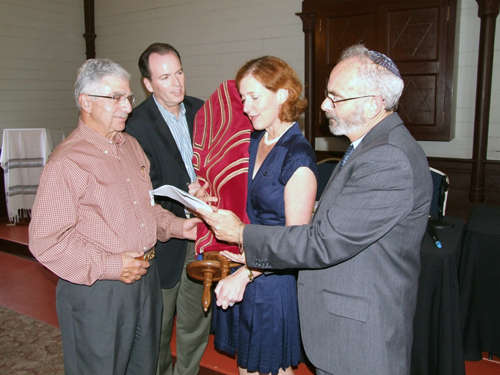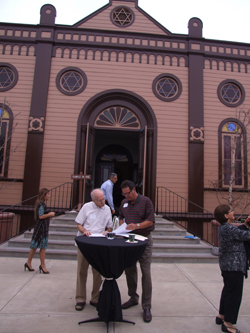
By Donald H. Harrison
SAN DIEGO—Congregation Beth Israel returned on Thursday night, Sept. 15, to its original home to install the president and board of directors who will preside over the Reform congregation’s sesquicentennial celebrations in the forthcoming year of the Hebrew calendar.
Like the congregation, the building to which Beth Israel’s board members and three clergy returned on Thursday no longer is located in its original venue. When the Victorian-style building with Star of David stained glass windows and the Tablets of the Law rising above its roof line hosted its inaugural services for Rosh Hashanah in 1889, it was located in the Banker’s Hill area of San Diego, at 2nd and Beech Streets. Today, along with other restored historical structures, it resides in the County of San Diego-operated Heritage Park a few blocks from Old Town San Diego State Historic Park.
Beth Israel has been located in a 65,000-square-foot-complex on three acres at 9001 Towne Center Drive in the University City/ East La Jolla area of San Diego since 2001. For the 75 years before then it was located in the synagogue building of Moorish design now occupied by Congregation Ohr Shalom, a Conservative congregation, at 3rd and Laurel Streets near Balboa Park.
On Thursday night, Rabbi Michael Berk installed Beth Israel board members who rose to their feet from pews that were not original to the initial temple. In 1889, at that first Rosh Hashanah service, men in hats and women wearing corsets, sat in “250 numbered chairs” in the sanctuary of the 50-by-36-foot building, braving September heat during an era before air conditioning, according to Stan Schwartz, president of the Jewish Historical Society of San Diego.
In a separate ceremony involving taking a Torah from the temple’s Ark and passing it down through former congregational presidents Ron Simon and Jeff Silberman, the new president, Emily Jennewein, was officially installed. “You lead a small but significant corner of the Jewish world,” Rabbi Berk told her. She in turn prayed aloud to be inspired by the “sweet words of the Torah.”

Schwartz, who also is the archivist for Beth Israel, and Rob Levi, the great-grandson of one of Beth Israel’s founders and third president, Adolph Levi, presented insights into a congregation that started in the horse-and-buggy era and which today thrives in times of fast automobiles, jet aircraft and deep-space-penetrating rocket ships.
The congregation began in 1861 calling itself Adath Jeshurun, and alternatively Adath Yeshurun – Hebrew for “gathering of the faithful.” Members gathered for holidays and simchas at each other’s homes and in rented halls, but did not feel sufficiently sure of their future in San Diego to build their own temple building until 1889. At the time the congregation organized to build the temple building, it formally changed its name to Beth Israel for “house of Israel.”
Marcus Schiller, a merchant, had been president of Adath Yeshurun and likewise was the first president of Beth Israel. But other leaders were coming the fore, including members of the Blochman and Levi families, Samuel I. Fox and Louis Mendelson. To help finance the $8,500 cost of the temple, the women of the congregation raised $2,200 at an outdoor fair at which a local newspaper noted that “Oriental” foods were featured, historian Schwartz reported. In those days, Jews were regarded as “Orientals” by many non-Jews.
The dues in those early days were $1 per month for single men, and $2 per month for married men. One of the congregation’s biggest problems was keeping chickens from wandering into the synagogue from the neighbor’s property, Schwartz said.
Levi said that his great-great uncle Simon Levi succeeded Schiller as president. Levi’s great-grandfather Adolph succeeded Simon, who was his brother, as president. Since then, he said, the Levi family had a long association with Beth Israel. “I was married here in 2001,” he smiled.
Rabbi Satz noted that when Beth Israel began, it associated itself with the Reform movement, which considered Americanism to be an important part of its ideology. In the movement’s Pittsburgh Platform of 1885, it declared its belief that the integration of Jewish life into the American mainstream was a mitzvah. America, Satz added, became an essential ingredient of the faith of Beth Israel’s founders.
The board installation presaged a year of celebration that will continue this Sunday at the La Jolla campus with a concert of Jewish themed music by Craig Taubman, and the introduction to the congregation of Julie Seltzer, the scribe who will write a new Torah scroll for use in its sacred services.
Thereafter, the congregation will host a speaker series that will start with a speech by Holocaust scholar Deborah Lipstadt on Nov. 11 and proceed with lectures by Rabbi David Wolpe, Kenneth Stein, Rabbi Eric Yoffie, Rabbi David Saperstein, Rabbi Leonard Thal and Rabbi David Ellenson. A closing celebration on May 19 will feature an appearance by actor Mandy Patinkin
*
Harrison is editor of San Diego Jewish World. He may be contacted at donald.harrison@sdjewishworld.com